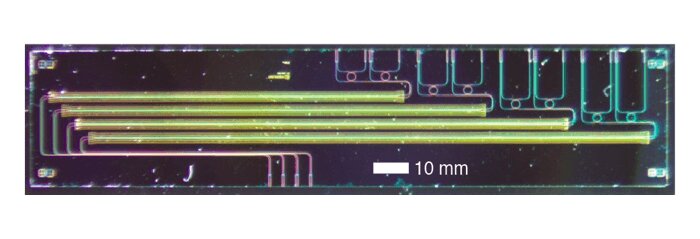An innovative optical isolator has been developed at the Harvard John A. Paulson School of Engineering and Applied Sciences (SEAS), with the potential to greatly enhance optical systems for various practical applications.
All optical systems, including those used in telecommunications, microscopy, imaging, quantum photonics, and more, rely on lasers for generating photons and beams of light. To protect these lasers from damage and instability, isolators are essential components that prevent light from traveling in unwanted directions. Isolators also help reduce signal noise by preventing light from bouncing around freely. However, conventional isolators have been relatively large in size and require multiple materials to be joined together, hindering performance enhancements.
Now, a team of researchers led by electrical engineer Marko Lončar at SEAS has developed a highly-efficient integrated isolator that seamlessly integrates into an optical chip made of lithium niobate. Their findings have been published in Nature Photonics.
“We have built a device that allows the emitted light from the laser to propagate without alteration, while the reflected light traveling back towards the laser changes its color and gets redirected away from the laser,” explained Lončar, Tiantsai Lin Professor of Electrical Engineering at SEAS. “This is achieved by sending electrical signals in the direction of the reflected optical signals, taking advantage of the excellent electro-optic properties of lithium niobate.” The properties of lithium niobate allow voltage to be applied, altering the properties of optical signals such as speed and color.
“Our aim was to create a safer operating environment for lasers, and by designing this one-way street for light, we can protect the device from the laser’s reflection,” said Mengjie Yu, co-first author on the paper and a former postdoctoral researcher in Lončar’s lab. “To our knowledge, this device offers the best optical isolation in the world compared to previous integrated isolator demonstrations. It also provides top performance in terms of loss, power efficiency, and tunability.”
“What’s exceptional about this device is its simplicity—it consists of just one single modulator,” added Rebecca Cheng, co-first author on the paper and a current Ph.D. student in Lončar’s lab. “Previous attempts to engineer such a device required multiple resonators and modulators. The remarkable performance we achieve is due to the properties of lithium niobate.”
The size of the device also contributes to its high performance and efficiency. The team fabricated a chip measuring 600 nanometers thick with etchings up to 320 nanometers deep at the Harvard Center for Nanoscale Systems.
“With a smaller device, light can be controlled more easily, and the proximity of light to the electrical signals allows for a stronger electrical field with the same voltage,” explained Yu. This enables more powerful control of light.
The smaller dimensions and ultralow loss property of this platform also increase optical power. “Since the light doesn’t have to travel as far, there is less decay and power loss,” added Cheng.
In addition, the team successfully demonstrated that the device can protect an on-chip laser from external reflection. “We are the first team to show the laser’s phase-stable operation under the protection of our optical isolator,” said Yu.
This advancement represents a significant breakthrough for practical, high-performance optical chips. The team states that the device can be used with various laser wavelengths, only requiring a counter-propagating electrical signal to achieve the desired effects.
The team hopes that this breakthrough, part of a larger effort to integrate lasers and photonics components on a chip at extremely small scales, will unlock new capabilities across various applications. These applications include the telecommunications industry and time-frequency transfer, a method of measuring time precisely at atomic and sub-atomic scales, which could have implications for quantum research and computing.
“Integrating all aspects of an optical system onto a single chip could replace larger, more expensive, and less efficient systems,” said Yu. “Combining all these elements could revolutionize many fields of work.”
More information:
Mengjie Yu et al, Integrated electro-optic isolator on thin-film lithium niobate, Nature Photonics (2023). DOI: 10.1038/s41566-023-01227-8
Citation:
Engineers develop first-of-its-kind integrated optical isolator (2023, June 29)
retrieved 29 June 2023
from https://phys.org/news/2023-06-first-of-its-kind-optical-isolator.html
This document is subject to copyright. Apart from any fair dealing for the purpose of private study or research, no
part may be reproduced without the written permission. The content is provided for information purposes only.
Denial of responsibility! TechCodex is an automatic aggregator of the all world’s media. In each content, the hyperlink to the primary source is specified. All trademarks belong to their rightful owners, and all materials to their authors. For any complaint, please reach us at – [email protected]. We will take necessary action within 24 hours.

Jessica Irvine is a tech enthusiast specializing in gadgets. From smart home devices to cutting-edge electronics, Jessica explores the world of consumer tech, offering readers comprehensive reviews, hands-on experiences, and expert insights into the coolest and most innovative gadgets on the market.


